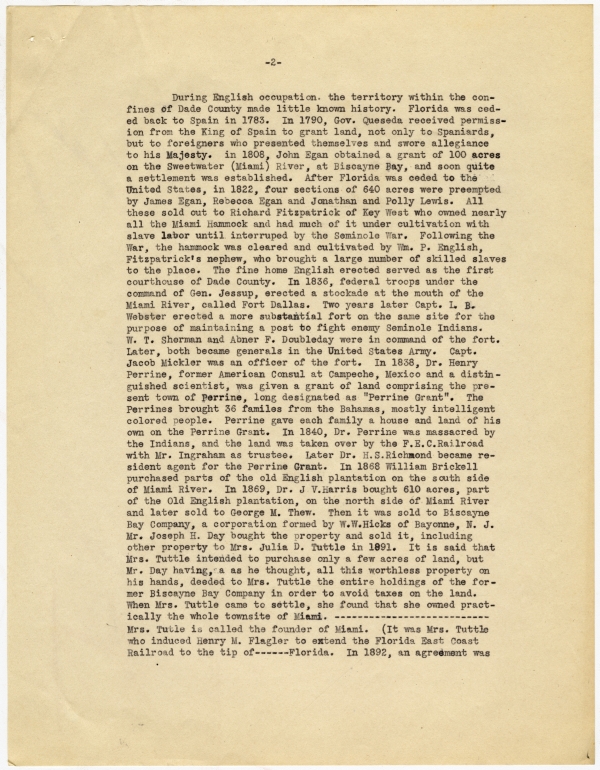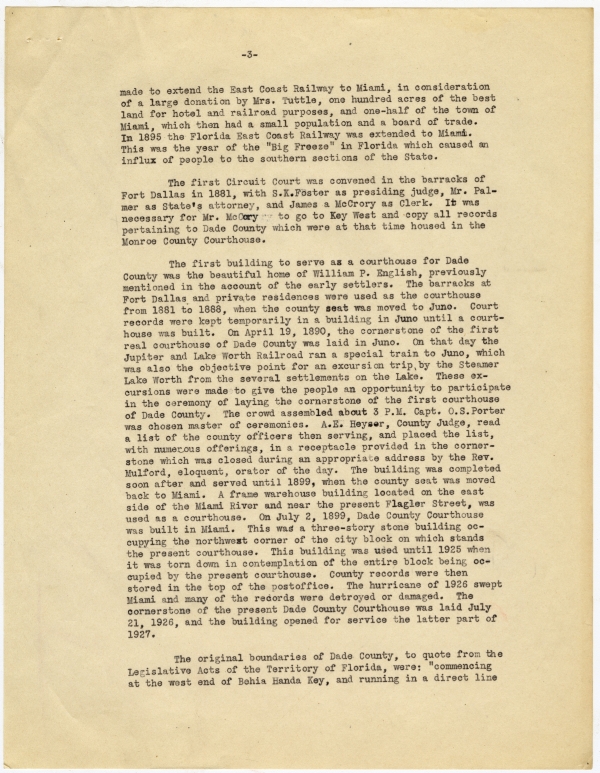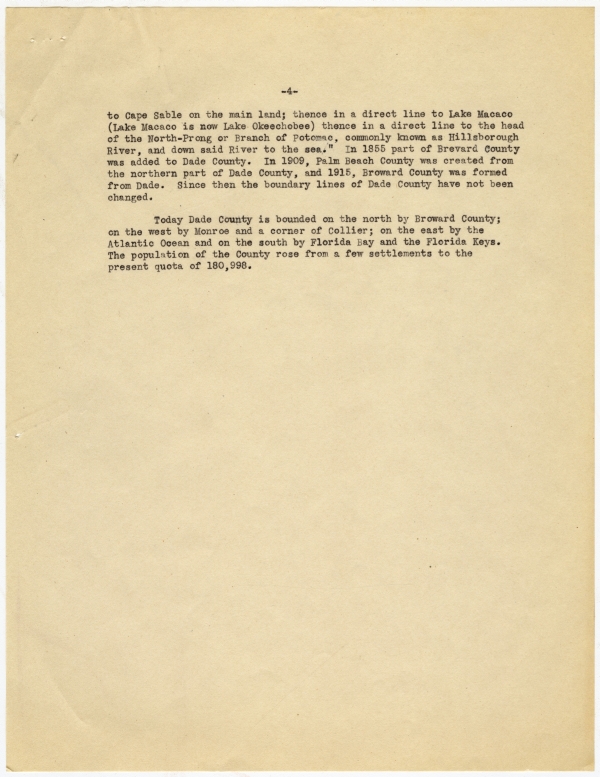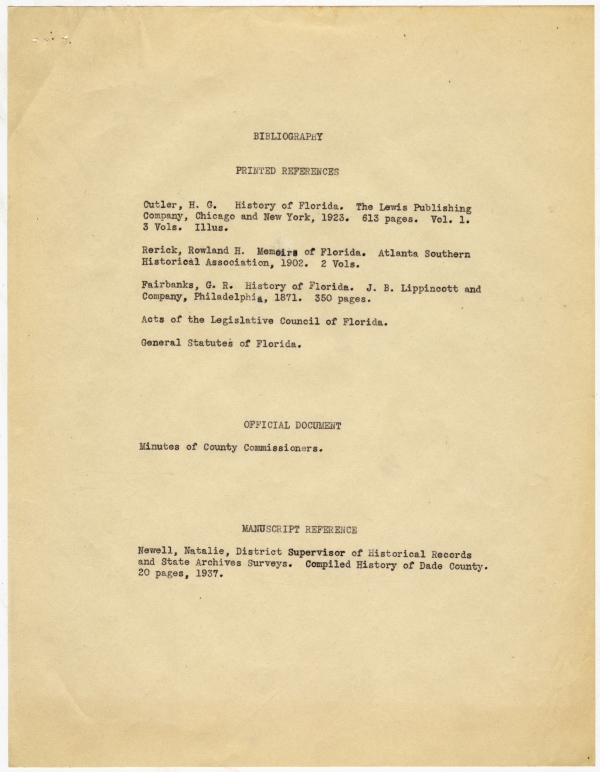WPA
HISTORICAL SKETCH OF DADE COUNTY
Dade County was created on February 4, 1836, by an Act of the Legislative Council of the Territory of Florida. The county was named in honor of Major Francis L. Dade, who was massacred by the Seminole Indians near Bushnell, in Sumter County, when on a march to the relief of Fort King. Miami was named as the county seat, but because of lack of population and inadequate facilities for keeping records in Miami, Dade County records, from 1836 to 1880, were kept in the county courthouse, Key West, county seat of Monroe County. In 1888 the county seat of Dade County was moved to Juno, but moved back to Miami in 1895. Since this date Miami has served as county seat of Dade County.
The history of the early settlement of Dade County begins with Esalante de Fontendada, probably the first white man to traverse the territory within the present limits of Dade County. This Spanish nobleman, the sole survivor of a galleon wrecked on the Florida Keys about 1545, was rescued by the Tekesta Indians and held in virtual slavery for 17 years. The territory was first inhabited by pirates and renegades. In the days of the early settlers of Florida pirate ships roamed the seas searching for loot. From 1809 to 1825 United States Revenue Cutters captured or forced on the rocks all pirate ships sailing along the southeastern coast of Florida; their officers and crews took to small boats or to the water for safety. Many of them landed on the present coast of Dade County, built shelters and lived on the land long enough to obtain squatters rights to the property. They lived by fishing, the manufacture of coontie starch from coontie root, and by "wrecking". Wrecking is the salvaging or collecting of cargo from a ship which has been wrecked. In time wrecking developed into a legitimate business of salvage.
The land was productive of many tropical foods and receptive of planting; however, the natives prepared to make their living from the sea. They became fishermen, spongers, and of necessity master navigators. There were practically no roads, the only means of transportation, even from neighbor to neighbor, was by water. Even their first land grant boundaries were determined by degrees and minutes and do not correspond with present section lines although the early land grants did contain the requisite 640 acres according to nautical measurements. Early settlers led a happy, carefree existence, unfettered by any laws except of their own making.
These early settlers of Florida, had a desperate struggle with the Indians and had many difficulties due to change of rule from one nationality to another. By right of conquest, Spain was in possession of Florida until Feb. 10, 1763, when the province was ceded to Great Britain in return for Cuba. After one hundered and ninety-eight years the territory passed from Spanish rule.
-2-
During English occupation the territory within the confines of Dade County made little known history. Florida was ceded back to Spain in 1783. In 1790, Gov. Queseda received permission from the King of Spain to grant land, not only to Spaniards, but to foreigners who presented themselves and swore allegiance to his Majesty. [In] 1808, John Egan obtained a grant of 100 acres on the Sweetwater (Miami) River, at Biscayne Bay, and soon quite a settlement was established. After Florida was ceded to the United States, in 1822, four sections of 640 acres were preempted by James Egan, Rebecca Egan and Jonathan and Polly Lewis. All these sold out to Richard Fitzpatrick of Key West who owned nearly all the Miami Hammock and had much of it under cultivation with slave labor until [interrupted] by the Seminole War. Following the War, the hammock was cleared and cultivated by Wm. P. English, Fitzpatrick's nephew, who brought a large number of skilled slaves to the place. The fine home English erected served as the first courthouse of Dade County. In 1836, federal troops under the command of Gen. Jessup, erected a stockade at the mouth of the Miami River, called Fort Dallas. Two years later Capt. I. B. Webster erected a more substantial fort on the same site for the purpose of maintaining a post to fight enemy Seminole Indians. W. T. Sherman and Abner F. Doubleday were in command of the fort. Later, both became generals in the United States Army. Capt. Jacob Mickler was an officer of the fort. In 1838, Dr. Henry Perrine, former American Consul at Campeche, Mexico and a distinguished scientist, was given a grant of land comprising the present town of Perrine, long designated as "Perrine Grant". The Perrines brought 36 [families] from the Bahamas, mostly intelligent colored people. Perrine gave each family a house and land of his own on the Perrine Grant. In 1840, Dr. Perrine was massacred by the Indians, and the land was taken over by the F. E. C. Railroad with Mr. Ingraham as trustee. Later Dr. H. S. Richmond became resident agent for the Perrine Grant. In 1868 William Brickell purchased parts of the old English plantation on the south side of Miami River. In 1869, Dr. J. V. Harris bought 610 acres, part of the Old English plantation, on the north side of Miami River and later sold to George M. Thew. Then it was sold to Biscayne Bay Company, a corporation formed by W. W. Hicks of Bayonne, N. J. Mr. Joseph H. Day bought the property and sold it, including other property to Mrs. Julia D. Tuttle in 1891. It is said that Mrs. Tuttle intended to purchase only a few acres of land, but Mr. Day having, a [sic] as he thought, all this worthless property on his hands, deeded to Mrs. Tuttle the entire holdings of the former Biscayne Bay Company in order to avoid taxes on the land. When Mrs. Tuttle came to settle, she found that she owned practically the shole townsite of Miami.--------------------------
Mrs. [Tuttle] is called the founder of Miami. (It was Mrs. Tuttle who induced Henry M. Flagler to extend the Florida East Coast Railroad to the tip of------Florida. In 1892, an agreement was
-3-
made to extend the East Coast Railway to Miami, in consideration of a large donation by Mrs. Tuttle, one hundred acres of the best land for hotel and railroad purposes, and one-half of the town of Miami, which then had a small population and a board of trade. In 1895 the Florida East Coast Railway was extended to Miami. This was the year of the "Big Freeze" in Florida which caused an influx of people to the southern sections of the State.
The first Circuit Court was convened in the barracks of Fort Dallas in 1881, with S. K. Foster as presiding judge, Mr. Palmer as State's attorney, and James [A] McCrory as Clerk. It was necessary for Mr. [McCrory] to go to Key West and copy all records pertaining to Dade County which were at that time housed in the Monroe County Courthouse.
The first building to serve as a courthouse for Dade County was the beautiful home of William P. English, previously mentioned in the account of the early settlers. The barracks at Fort Dallas and private residences were used as the courthouse from 1881 to 1888, when the county seat was moved to Juno. Court records were kept temporarily in a building in Juno until a courthouse was built. On April 19, 1890, the cornerstone of the first real courthouse of Dade County was laid in Juno. On that day the Jupiter and Lake Worth Railroad ran a special train to Juno, which was also the objective point for an excursion trip by the Steamer Lake Worth from the several settlements on the Lake. These excursions were made to give the people an opportunity to participate in the ceremony of laying the cornerstone of the first courthouse of Dade County. The crowd assembled about 3 P.M. Capt. O. S. Porter was chosen master of ceremonies. A. E. Heyser, County Judge, read a list of the county officers then serving, and placed the list, with numerous offerings, in a receptable provided in the cornerstone which was closed during an appropriate address by the Rev. Mulford, eloquent, orator of the day. The building was completed soon after and served until 1899, when the county seat was moved back to Miami. A frame warehouse building located on the east side of the Miami River and near the present Flagler Street, was used as a courthouse. On July 2, 1899, Dade County Courthouse was built in Miami. This was a three-story stone building occupying the northwest corner of the city block on which stands the present courthouse. This building was used until 1925 when it was torn down in contemplation of the entire block being occupied by the present courthouse. County records were then stored in the top of the postoffice. The hurricane of 1926 swept Miami and many of the records were [destroyed] or damaged. The cornerstone of the present Dade County Courthouse was laid July 21, 1926, and the building opened for service the latter part of 1927.
The original boundaries of Dade County, to quote from the Legislative Acts of the Territory of Florida, were: "commencing at the west end of Behia Handa Key, and running in a direct line
-4-
to Cape Sable on the main land; thence in a direct line to Lake Macaco (Lake Macaco is now Lake Okeechobee) thence in a direct line to the head of the North-Prong or Branch of Potomac, commonly known as Hillsborough River, and down said River to the sea." In 1855 part of Brevard County was added to Dade County. In 1909, Palm Beach County was created from the northern part of Dade County, and 1915, Broward County was formed from Dade. Since then the boundary lines of Dade County have not been changed.
Today Dade County is bounded on the north by Broward County; on the west by Monroe and a corner of Collier; on the east by the Atlantic Ocean and on the south by Florida Bay and the Florida Keys. The population of the County rose from a few settlements to the present quota of 180,998.
BIBLIOGRAPHY
PRINTED REFERENCES
Cutler, H. G. History of Florida. The Lewis Publishing Company, Chicago and New York, 1923. 613 pages. Vol 1. 3 Vols. Illus.
Rerick, Rowland H. Memoirs of Florida. Atlanta Southern Historical Association, 1902. 2 Vols.
Fairbanks, G. R. History of Florida. J. B. Lippincott and Company, Philadelphia, 1871. 350 pages.
Acts of the Legislative Council of Florida.
General Statutes of Florida.
OFFICIAL DOCUMENT
Minutes of County Commissioners.
MANUSCRIPT REFERENCE
Newell, Natalie, District Supervisor of Historical Records and State Archives Surveys. Compiled History of Dade County. 20 pages, 1937.

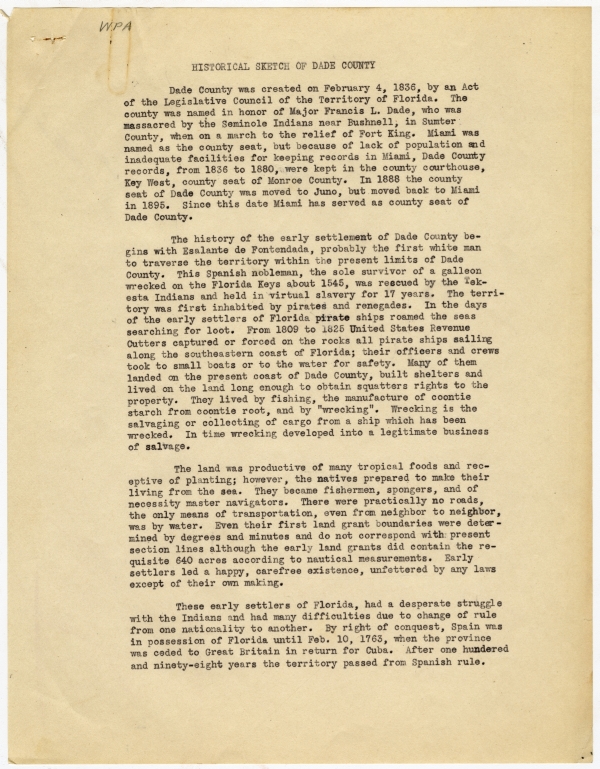


 Listen: The Blues Program
Listen: The Blues Program